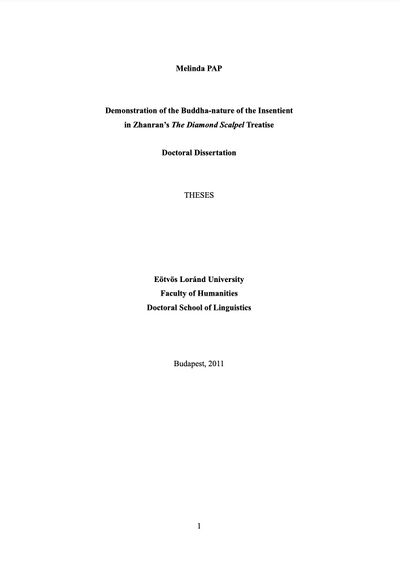Demonstration of the Buddha-nature of the Insentient in Zhanran’s The Diamond Scalpel Treatise
< Books
The theme of the dissertation is the idea of Buddha-nature of the insentient (wuqing you xing 無情有性) as presented in the most prominent work of the Tang Dynasty (618−907) Tiantai 天 台 monk, Zhanran 湛 然 (711−782), The Diamond Scalpel (Jin’gang bei 金 剛 錍 ; T46:1932) treatise. The objective of the dissertation is a new translation of The Diamond Scalpel, completed with translations from commentaries written to it, a thorough and detailed analysis and explanation of the text, including a definition of the notions and ideas presented in it, furthermore a study of the idea of Buddha-nature former to Zhanran, a definition of its role and interpretations in Chinese Buddhism, essential to understanding the treatise itself.
The dissertation includes four main chapters, these are: I. Zhanran's biography; II. The idea of Buddha-nature in Chinese Buddhism; III. Demonstration of the Buddha-nature of the insentient in Zhanran’s The Diamond Scalpel treatise; IV. Summary.
In the first chapter Zhanran’s life is presented through a translation, comparison and analysis
of the chapters dealing with Zhanran’s life from the biographies of monks written in the Song
Dynasty (960−1279). Biographies besides historical data also contain several miraculous elements, thus, this first chapter also provides a glimpse into the world of Buddhist biographies. This chapter also briefly introduces the reader into the history of Tiantai school before Zhanran, therefore this is placed at the beginning of the dissertation.
Because the main theme of Zhanran’s treatise is the Buddha-nature of the insentient, the translation and analysis of the text is preceded by a chapter on the idea of Buddha-nature, focusing on its apparition, evolution an interpretations in Chinese Buddhism. This chapter is divided into two major parts, the first part gives a presentation of those sūtras and treatises, which had the greatest influence on the formation of Chinese interpretations of the notion. The second part deals with those Chinese traditions and schools, thinkers and ideas, which had great impact on the formation of the Chinese Buddha-nature theory. While presenting certain writings, schools and thinkers a greater emphasis is laid on those ideas, which appear in The Diamond Scalpel, or can be proven to have influenced Zhanran’s philosophy. Thus, both the premises for Zhanran’s conclusion and the ideas to be refuted clear out. The objective of this chapter is to place Zhanran’s work in a greater context, and to determine those antecedents, that lead Zhanran towards the formulation of his ideas.
The third, most important and most extensive chapter is the translation of The Diamond Scalpel, complemented with translations from commentaries written to it, detailed analysis and interpretation of the text divided into sixty separate chapters. One of the most important objectives is to grasp the main ideas, and provide this difficult text a clear and easily understandable interpretation.
The fourth chapter consists of a summary of the main ideas presented in The Diamond Scalpel, and an overall analysis of the text. (Pap, "Theme and Objective of the Research," 1–3)
| Citation | Pap, Melinda. "Demonstration of the Buddha-Nature of the Insentient in Zhanran’s The Diamond Scalpel Treatise." PhD diss., Budapest: Eötvös Loránd University, 2011. http://doktori.btk.elte.hu/lingv/papmelinda/thesis.pdf |
|---|---|

